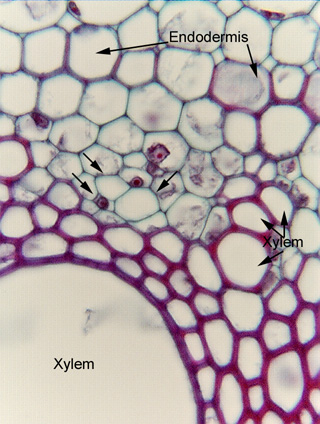 Fig.
8.1-8.
Transverse section of root of corn (Zea mays). The phloem in this monocot
root is much more difficult to identify than that in cat claw (Fig. 8.1-7). The
arrows point out a companion cell and two sieve tube members. There are several
other cells that have the proper size and shape, but which have cell contents:
those are probably sieve tube members that are still differentiating and have
not yet reached the stage of losing their nuclei and vacuole membrane. Note the
location of the phloem: just to the side of a mass of xylem and just interior to
the endodermis. One of the objectives of this micrograph is to let you know that
if you sometimes have trouble identifying phloem -- don't feel bad, it can be a
problem for all of us.
Fig.
8.1-8.
Transverse section of root of corn (Zea mays). The phloem in this monocot
root is much more difficult to identify than that in cat claw (Fig. 8.1-7). The
arrows point out a companion cell and two sieve tube members. There are several
other cells that have the proper size and shape, but which have cell contents:
those are probably sieve tube members that are still differentiating and have
not yet reached the stage of losing their nuclei and vacuole membrane. Note the
location of the phloem: just to the side of a mass of xylem and just interior to
the endodermis. One of the objectives of this micrograph is to let you know that
if you sometimes have trouble identifying phloem -- don't feel bad, it can be a
problem for all of us.